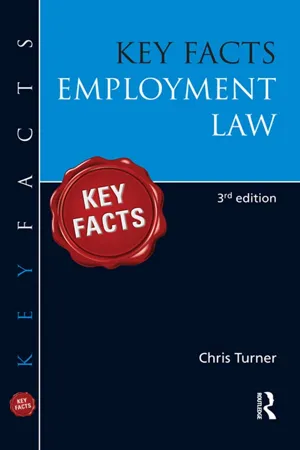
eBook - ePub
Key Facts: Employment Law
Chris Turner
This is a test
Partager le livre
- 154 pages
- English
- ePUB (adapté aux mobiles)
- Disponible sur iOS et Android
eBook - ePub
Key Facts: Employment Law
Chris Turner
Détails du livre
Aperçu du livre
Table des matières
Citations
À propos de ce livre
Key Facts is the essential series for anyone studying law, including LLB, ILEX and post-graduate conversion courses. Key Facts provides the simplest and most effective way for you to memorise and absorb the essential facts needed to pass your exams. Key Features:
* User-friendly layout and style
* Diagrams, charts and tables to illustrate key points
* Summary charts at a basic level, followed by more detailed explanations to aid revision at every level Additional high-quality revision material is provided on the interactive website www.unlockingthelaw.co.uk
Foire aux questions
Comment puis-je résilier mon abonnement ?
Il vous suffit de vous rendre dans la section compte dans paramètres et de cliquer sur « Résilier l’abonnement ». C’est aussi simple que cela ! Une fois que vous aurez résilié votre abonnement, il restera actif pour le reste de la période pour laquelle vous avez payé. Découvrez-en plus ici.
Puis-je / comment puis-je télécharger des livres ?
Pour le moment, tous nos livres en format ePub adaptés aux mobiles peuvent être téléchargés via l’application. La plupart de nos PDF sont également disponibles en téléchargement et les autres seront téléchargeables très prochainement. Découvrez-en plus ici.
Quelle est la différence entre les formules tarifaires ?
Les deux abonnements vous donnent un accès complet à la bibliothèque et à toutes les fonctionnalités de Perlego. Les seules différences sont les tarifs ainsi que la période d’abonnement : avec l’abonnement annuel, vous économiserez environ 30 % par rapport à 12 mois d’abonnement mensuel.
Qu’est-ce que Perlego ?
Nous sommes un service d’abonnement à des ouvrages universitaires en ligne, où vous pouvez accéder à toute une bibliothèque pour un prix inférieur à celui d’un seul livre par mois. Avec plus d’un million de livres sur plus de 1 000 sujets, nous avons ce qu’il vous faut ! Découvrez-en plus ici.
Prenez-vous en charge la synthèse vocale ?
Recherchez le symbole Écouter sur votre prochain livre pour voir si vous pouvez l’écouter. L’outil Écouter lit le texte à haute voix pour vous, en surlignant le passage qui est en cours de lecture. Vous pouvez le mettre sur pause, l’accélérer ou le ralentir. Découvrez-en plus ici.
Est-ce que Key Facts: Employment Law est un PDF/ePUB en ligne ?
Oui, vous pouvez accéder à Key Facts: Employment Law par Chris Turner en format PDF et/ou ePUB ainsi qu’à d’autres livres populaires dans Derecho et Teoría y práctica del derecho. Nous disposons de plus d’un million d’ouvrages à découvrir dans notre catalogue.
Informations
1
The Historical Background to Employment Law
1.1 The Development of Employment Protections
1.1.1 The History and Background to Employment Law
1. Regulating employment goes back as far as Statute of Labourers 1399 and Statute of Artificers and Apprentices 1652.
2. So while employment is based on a contractual relationship it has always been subject to statutory intervention.
3. Modern employment law begins with the so-called ‘master and servant laws’ of the nineteenth century and always an unequal relationship (Latter v Braddell (1881)).
1.1.2 The Scope of Employment Law
1. Divides into three neat areas:
(i) industrial safety law;
(ii) employment law;
(iii) industrial relations law.
2. Industrial safety law developed through nineteenth century statutes, common law duty, the Health & Safety at Work Act 1974 and EU intervention.
3. Employment law is based on contract law.
4. Industrial relations have always been led by politics, and subject to violent change and great controversy.
1.1.3 Development of Employment Rights and Protections
1. Early twentieth century saw other measures to curb exploitation e.g. Wages Councils.
2. In the 1950s, conditions were generally settled by free collective bargaining – ‘collective laissez faire’ Otto Kahn-Freund.
3. Move towards a basic ‘floor of rights’ emerged in the 1960s:



4. Donovan Commission 1968 suggested pay bargaining at local level to improve productivity and resolve differences quickly.
5. Labour followed this with White Paper ‘In place of strife’.
6. Industrial Relations Act 1971 tried to create framework for industrial relations, failed but introduced unfair dismissal.
7. Labour 1974–1979 introduced consolidation package with:


8. EU has also been major source of increased employee rights:



1.1.4 Reductions of Employee Rights
1. Legislation of 1980s-1990s restricted rights and protections:







